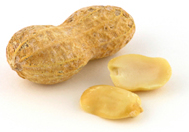

Peanuts

Arachis. (From Greek a-, without, and rachos, branch). Leguminosae (Papilionoideae). Twenty two species of annual or perennial herbs. Stems prostrate, rarely erect. Leaves imparipinnate; stipules persistent. Flowers sessile, in short, dense axillary spikes; calyx papery, 5-lobed, 4 upper lobes joined, lower almost free; standard rounded, wings free, keel beaked, incurved; stamens 8-10, 4-5 exserted, alternating with 4-5 shorter ones. Fruit developing below ground, oblong or swollen cylindric, weakly turulose, somewhat curved, woody-fibrous textured and strongly reticulate; seeds ovoid or oblong. S America. Arachis hypogaea, no longer known in its wild state, has been cultivated for many centuries in the Old World and in South America, where it originated. CultivationPeanuts, a staple food in many tropical and subtropical zones, are rich in oil, proteins, minerals and vitamins, especially B complex. The oil, similar in composition to olive oil, is used in margarines and salad oils; the harvested vines and pressed cake as cattle feed. In the southern states of America, Arachis hypogaea has been used as an alternative crop when boll weevil has rendered cotton unprofitable and it is frequently used in rotation with cotton and sweet corn (zea). In commercial production, yields of one tonne of unshelled nuts per hectare are average; the weight percentage of shelled nuts to harvested pods to 80% for bunch types, 60-75% for runners. Arachis hypogaea grows well in areas suited to the cultivation of citrus, sweet corn, cotton and olives, between latitudinal limits 40ºS and 40ºN, with a minimum rainfall of 500mm during the growing season. There are three groups of cultivars, Virginia, with large seeds; Valencia, with four seeds per pod, and Spanish; all groups include cultivars with both the runner (spreading) and bunch (erect) habit. Peanuts are killed by frost and require a long warm period to reach maturity; bunch types mature in 15 weeks, runners take up to 20 weeks. In frost-free zones, grow in a light, humus-rich, well-drained and well-aerated sandy loam soil, limed if acid; keep soils weed free during the first eight weeks. In commercial cultivation, the application of fertiliser is adjusted according to leaf and soil analysis; on a small scale, the primary requirement for calcium and potash can be met by application of a general-purpose fertiliser. The flower stalks (‘pegs’), bury the ovaries in the soil at flower drop, and the fruiting pod is formed underground; it is essential at this stage that the soil is friable to enable the peg to penetrate. Ripeness is indicated by a yellowing of the foliage; lift the whole plant and sun-dry. 
In cool temperate zones, Arachis hypogaea is sometimes grown for interest or in educational collections of economically important plants, where it is unlikely to produce impressive crops. Select bunch-type cultivars, which take up less space and mature sooner. Sow under glass in spring, planting out when all danger of frost has passed, spacing at 15-20cm between plants, in rows 75cm apart. Grow in full sun and in well-drained soil. Alternatively, grow under glass with a minimum temperature of 10-13ºC, direct sun and good ventilation, in pans or boxes of sandy, loam-based medium. Water moderately when in growth and apply a dilute liquid feed once or twice weekly. Reduce water during ripening, when hot dry conditions are necessary. Pests and diseases include caterpillars, thrips and aphids; Cercospora leaf spot, Sclerotium wilt and Pseudomonas wilt are serious diseases on commercial crops. Arachis hypogaeaPEANUT; GROUNDNUT; MONKEY NUT. Annual erect or straggling procumbent herb to 30cm. Leaves 4-foliolate; leaflets 1-7 x 1-3cm, obovate or elliptic, glabrous or sparsely pilose beneath; stipules to 4cm, free part linear-lanceolate. Flowers to 4cm, axillary; standard to 1.5cm, yellow veined red. Fruit to 6 x 1.5cm, gynophore elongating to 20cm; seeds to 2cm, 1-3, irregularly ovoid. Summer. Z8.
|
Home
Grow Herbs
Grow Fruit
Grow Vegetables
Cyberian Index
If you like this website and want one of your own contact
Cyberian All information correct at
time of publication and open to updates as necessary. No part of this website,
or its vectors, may be produced in any shape or form, using any type or design
of medium, system, equipment or otherwise without the prior written consensual
notice of the Cyberian. Any breach of these requirements will result in the
appropriate action. If in doubt, e-mail contact is recommended.
Some components of this website were obtained as open-source software and are
used in the same non-profit manner on this website.